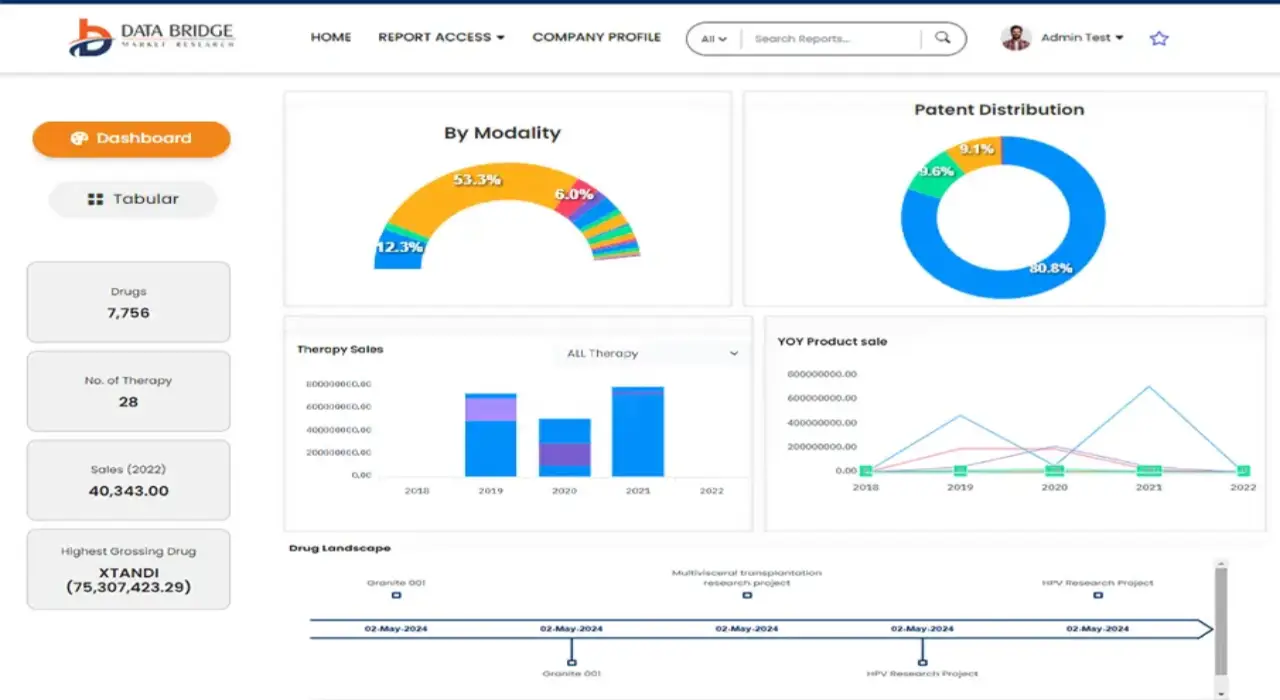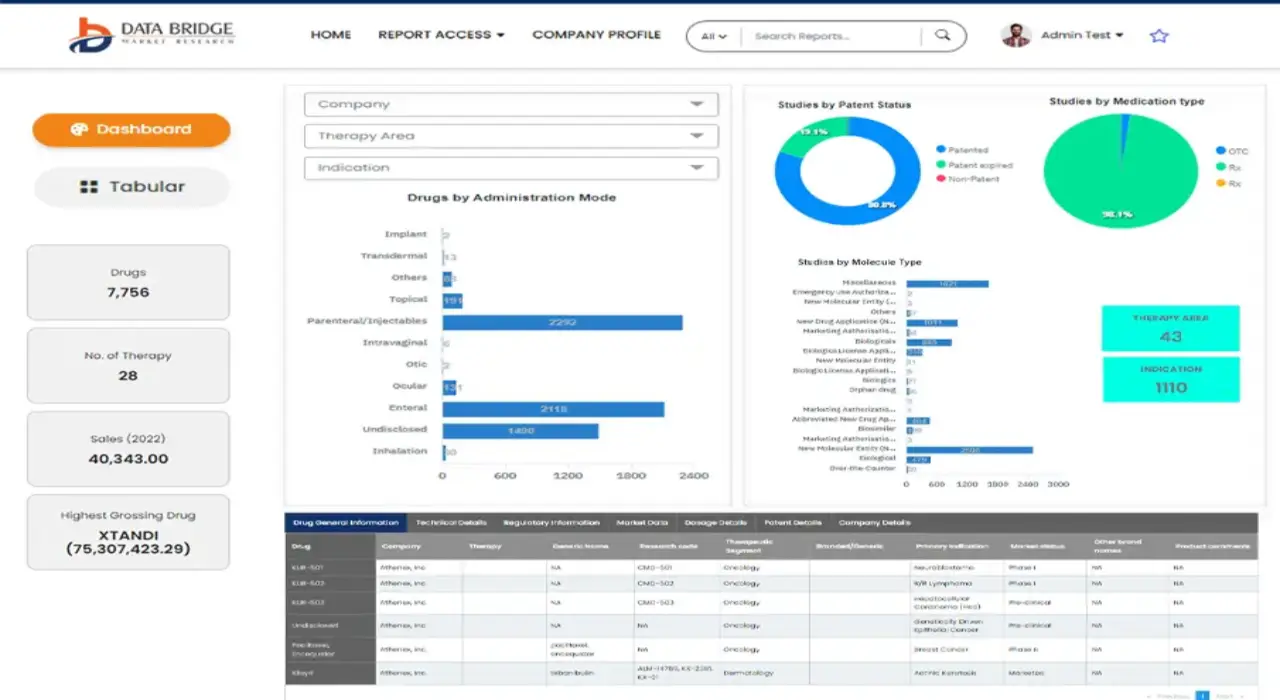Global Antisynthetase Syndrome Market
Market Size in USD Million
CAGR :
% 
 USD
235.56 Million
USD
382.59 Million
2024
2032
USD
235.56 Million
USD
382.59 Million
2024
2032
| 2025 –2032 | |
| USD 235.56 Million | |
| USD 382.59 Million | |
|
|
|
|
Global Antisynthetase Syndrome Market Segmentation, By Symptoms (Muscle Disease, Interstitial Lung Disease, and Arthritis), Gender (Male and Female), Diagnosis (Clinical Testing and Workup), Treatment (Medication, and Physical Therapy) – Industry Trends and Forecast to 2032
Antisynthetase Syndrome Market Analysis
The antisynthetase syndrome market is gaining attention due to the increasing prevalence of autoimmune disorders and advancements in diagnostic and therapeutic approaches. Antisynthetase syndrome is a rare autoimmune condition characterized by interstitial lung disease, myositis, and arthritis, driven by autoantibodies targeting aminoacyl-tRNA synthetases. The market's growth is propelled by improved awareness among healthcare providers and the development of advanced diagnostic tools enabling early detection. Recent developments include innovations in biologics and immunomodulatory therapies targeting disease pathways, offering better symptom management and improved patient outcomes. In addition, ongoing research into precision medicine and gene therapies holds promise for future treatment options. Despite challenges such as high treatment costs and limited awareness in underdeveloped regions, collaborations between key industry players and research institutions are driving advancements. The market is anticipated to expand as stakeholders focus on developing targeted, effective therapies for managing this complex autoimmune condition.
Antisynthetase Syndrome Market Size
The global antisynthetase syndrome market size was valued at USD 235.56 million in 2024 and is projected to reach USD 382.59 million by 2032, with a CAGR of 6.25% during the forecast period of 2025 to 2032. In addition to the insights on market scenarios such as market value, growth rate, segmentation, geographical coverage, and major players, the market reports curated by the Data Bridge Market Research also include depth expert analysis, patient epidemiology, pipeline analysis, pricing analysis, and regulatory framework.
Antisynthetase Syndrome Market Trends
“Advancements in Autoimmune Disease”
The antisynthetase syndrome market is witnessing notable growth due to advancements in autoimmune disease research and increasing awareness among healthcare providers. This rare condition, marked by interstitial lung disease, myositis, and arthritis, has prompted innovation in diagnostic and therapeutic approaches. A key trend shaping the market is the rise of biologic therapies, such as monoclonal antibodies, which target specific immune pathways for enhanced disease management. These innovative treatments aim to improve outcomes and reduce side effects, offering a more precise approach to therapy. In addition, the integration of personalized medicine and biomarker-based diagnostics is driving a shift towards tailored treatment plans. The market is poised for expansion as demand for effective and targeted solutions continues to grow.
Report Scope and Antisynthetase Syndrome Market Segmentation
|
Attributes |
Antisynthetase Syndrome Key Market Insights |
|
Segments Covered |
|
|
Countries Covered |
U.S., Canada and Mexico, Germany, France, U.K., Netherlands, Switzerland, Belgium, Russia, Italy, Spain, Turkey, Rest of Europe, China, Japan, India, South Korea, Singapore, Malaysia, Australia, Thailand, Indonesia, Philippines, Rest of Asia-Pacific, Saudi Arabia, U.A.E., South Africa, Egypt, Israel, Rest of Middle East and Africa , Brazil, Argentina and Rest of South America |
|
Key Market Players |
Teva Pharmaceutical Industries Ltd. (Israel), Pfizer Inc. (U.S.), Dr. Reddy’s Laboratories Ltd. (India), GSK plc (U.K.), Sun Pharmaceutical Industries Ltd. (India), Cipla (India), Sandoz Group AG (Germany), Glenmark Pharmaceuticals Ltd. (India), Zydus Group (India), Lupin (India), Viatris Inc. (U.S.), and Accord Healthcare (U.K.) |
|
Market Opportunities |
|
|
Value Added Data Infosets |
In addition to the insights on market scenarios such as market value, growth rate, segmentation, geographical coverage, and major players, the market reports curated by the Data Bridge Market Research also include depth expert analysis, patient epidemiology, pipeline analysis, pricing analysis, and regulatory framework. |
Antisynthetase Syndrome Market Definition
Antisynthetase syndrome is a rare autoimmune disorder characterized by a group of symptoms, including interstitial lung disease, muscle weakness (myositis), and arthritis, caused by the presence of autoantibodies targeting aminoacyl-tRNA synthetases. These enzymes play a key role in protein synthesis, and when the immune system mistakenly attacks them, it leads to inflammation and damage in various organs, especially the lungs and muscles. The condition often presents with distinctive clinical features such as "mechanic’s hands" (thickened, cracked skin on the palms) and can vary significantly in severity among affected individuals.
Antisynthetase Syndrome Market Dynamics
Drivers
- Increasing Awareness and Early Diagnosis
As healthcare professionals become more familiar with antisynthetase syndrome, early diagnosis and timely intervention have significantly improved. Increased awareness among clinicians about the condition's symptoms and complexities leads to quicker identification and more effective treatment options, reducing delays in care. This improved understanding of the disease enhances patient outcomes and fosters a growing demand for specialized therapies. As a result, the market for antisynthetase syndrome treatments is expanding, with healthcare providers seeking more targeted, personalized treatment options to address the unique needs of patients. This shift towards early diagnosis and better care is a key driver for market growth.
- Development of Novel Biologic Therapies
The development of novel biologic therapies, such as monoclonal antibodies and immunomodulatory treatments, has revolutionized the management of antisynthetase syndrome. These therapies specifically target immune system pathways, offering more precise disease control while minimizing side effects compared to traditional treatments. By reducing inflammation and preventing further damage to vital organs, biologics have significantly improved patient outcomes and quality of life. As these therapies become more accessible, the demand for them continues to rise, fueling market growth. The ongoing innovation in biologic treatments plays a crucial role in addressing the unmet needs of patients with antisynthetase syndrome, driving further expansion in the market.
Opportunities
- Gene Therapy and Precision Medicine
Advancements in gene therapy and personalized medicine present significant opportunities for the treatment of antisynthetase syndrome. These innovative approaches aim to target the underlying genetic causes of the disease, potentially offering long-term solutions that go beyond symptom management. By tailoring therapies to individual patient profiles, personalized medicine can optimize treatment outcomes and reduce side effects, enhancing the quality of life for patients. As these technologies continue to evolve, they hold the potential to transform the way antisynthetase syndrome is treated, driving substantial growth in the market. This personalized approach is a key opportunity for expanding treatment options and improving patient care.
- Personalized Medicine
Precision medicine, which focuses on tailoring treatments based on specific autoantibodies and genetic markers unique to each patient, presents a transformative opportunity in the antisynthetase syndrome market. By leveraging advancements in genomics and immunology, healthcare providers can identify patient subgroups more likely to respond to targeted therapies, enhancing treatment efficacy and reducing adverse effects. This approach enables the development of specialized biologics and immunomodulators designed to address the distinct autoimmune mechanisms of the disease. As research progresses, precision medicine improves patient outcomes and encourages pharmaceutical innovation, positioning it as a significant growth driver in this niche market.
Restraints/Challenges
- Limited Treatment Options
Although biologic therapies have shown promising results in managing antisynthetase syndrome, there is still a lack of standardized treatment protocols. The condition's rarity and complexity contribute to the absence of established guidelines for its management, making treatment decisions highly individualized. Many therapies are still in the experimental phase, and their long-term efficacy and safety remain under investigation. This uncertainty, coupled with the lack of consensus on the most effective treatments, creates an unmet need for more reliable and widely accepted therapeutic options. This challenge impedes the market's growth, as healthcare providers and patients await clearer treatment pathways.
- High Treatment Costs
Biologic therapies and advanced treatments for antisynthetase syndrome, while effective, are often expensive to develop and administer. The high cost of these therapies can create significant barriers to access, especially for patients in regions with limited healthcare resources or lower-income areas. As a result, many patients may not have access to the most advanced treatments, which can limit their ability to manage the condition effectively. This affordability challenge, combined with the financial burden placed on healthcare systems, represents a key restraint for the market, potentially slowing its growth and hindering the widespread adoption of these therapies.
This market report provides details of new recent developments, trade regulations, import-export analysis, production analysis, value chain optimization, market share, impact of domestic and localized market players, analyses opportunities in terms of emerging revenue pockets, changes in market regulations, strategic market growth analysis, market size, category market growths, application niches and dominance, product approvals, product launches, geographic expansions, technological innovations in the market. To gain more info on the market contact Data Bridge Market Research for an Analyst Brief, our team will help you take an informed market decision to achieve market growth.
Antisynthetase Syndrome Market Scope
The market is segmented on the basis of symptoms, gender, diagnosis and treatment. The growth amongst these segments will help you analyse meagre growth segments in the industries and provide the users with a valuable market overview and market insights to help them make strategic decisions for identifying core market applications.
Symptoms
- Muscle Disease
- Interstitial Lung Disease
- Arthritis
Gender
- Male
- Female
Diagnosis
- Clinical Testing
- Workup
Treatment
- Medication
- Physical Therapy
Antisynthetase Syndrome Market Regional Analysis
The market is analysed and market size insights and trends are provided by country, symptoms, gender, diagnosis and treatment as referenced above.
The countries covered in the market report are U.S., Canada and Mexico, Germany, France, U.K., Netherlands, Switzerland, Belgium, Russia, Italy, Spain, Turkey, rest of Europe, China, Japan, India, South Korea, Singapore, Malaysia, Australia, Thailand, Indonesia, Philippines, rest of Asia-Pacific, Saudi Arabia, U.A.E., South Africa, Egypt, Israel, rest of Middle East and Africa , Brazil, Argentina and rest of South America.
North America is the dominant region in the antisynthetase syndrome market, driven by increased government investment in healthcare and significant healthcare spending. The region's robust healthcare infrastructure and focus on advanced treatment options further contribute to its leadership in the market. This strong financial support and commitment to improving patient outcomes help propel market growth in North America.
The Asia-Pacific region is projected to experience substantial growth from 2025 to 2032, driven by increasing awareness of antisynthetase syndrome. As more individuals and healthcare professionals recognize the disease, early diagnosis and treatment are expected to improve, further boosting market demand. The growing awareness is anticipated to play a crucial role in the region's expanding market share during this period.
The country section of the report also provides individual market impacting factors and changes in regulation in the market domestically that impacts the current and future trends of the market. Data points such as down-stream and upstream value chain analysis, technical trends and porter's five forces analysis, case studies are some of the pointers used to forecast the market scenario for individual countries. Also, the presence and availability of global brands and their challenges faced due to large or scarce competition from local and domestic brands, impact of domestic tariffs and trade routes are considered while providing forecast analysis of the country data.
Antisynthetase Syndrome Market Share
The market competitive landscape provides details by competitor. Details included are company overview, company financials, revenue generated, market potential, investment in research and development, new market initiatives, global presence, production sites and facilities, production capacities, company strengths and weaknesses, product launch, product width and breadth, application dominance. The above data points provided are only related to the companies' focus related to market.
Antisynthetase Syndrome Market Leaders Operating in the Market Are:
- Teva Pharmaceutical Industries Ltd. (Israel)
- Pfizer Inc. (U.S.)
- Dr. Reddy’s Laboratories Ltd. (India)
- GSK plc (U.K.)
- Sun Pharmaceutical Industries Ltd. (India)
- Cipla (India)
- Sandoz Group AG (Germany)
- GLENMARK PHARMACEUTICALS LTD (India)
- Zydus Group (India)
- Lupin (India)
- Viatris Inc. (U.S.)
- Accord Healthcare (U.K.)
SKU-
Get online access to the report on the World's First Market Intelligence Cloud
- Interactive Data Analysis Dashboard
- Company Analysis Dashboard for high growth potential opportunities
- Research Analyst Access for customization & queries
- Competitor Analysis with Interactive dashboard
- Latest News, Updates & Trend analysis
- Harness the Power of Benchmark Analysis for Comprehensive Competitor Tracking
Research Methodology
Data collection and base year analysis are done using data collection modules with large sample sizes. The stage includes obtaining market information or related data through various sources and strategies. It includes examining and planning all the data acquired from the past in advance. It likewise envelops the examination of information inconsistencies seen across different information sources. The market data is analysed and estimated using market statistical and coherent models. Also, market share analysis and key trend analysis are the major success factors in the market report. To know more, please request an analyst call or drop down your inquiry.
The key research methodology used by DBMR research team is data triangulation which involves data mining, analysis of the impact of data variables on the market and primary (industry expert) validation. Data models include Vendor Positioning Grid, Market Time Line Analysis, Market Overview and Guide, Company Positioning Grid, Patent Analysis, Pricing Analysis, Company Market Share Analysis, Standards of Measurement, Global versus Regional and Vendor Share Analysis. To know more about the research methodology, drop in an inquiry to speak to our industry experts.
Customization Available
Data Bridge Market Research is a leader in advanced formative research. We take pride in servicing our existing and new customers with data and analysis that match and suits their goal. The report can be customized to include price trend analysis of target brands understanding the market for additional countries (ask for the list of countries), clinical trial results data, literature review, refurbished market and product base analysis. Market analysis of target competitors can be analyzed from technology-based analysis to market portfolio strategies. We can add as many competitors that you require data about in the format and data style you are looking for. Our team of analysts can also provide you data in crude raw excel files pivot tables (Fact book) or can assist you in creating presentations from the data sets available in the report.













